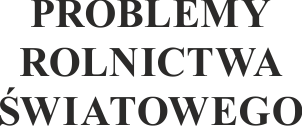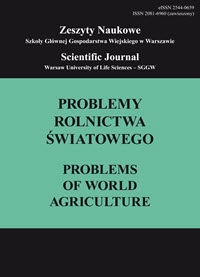Main Article Content
Article Details
Adamowicz, M. (2017). Biogospodarka – koncepcja, zastosowanie i perspektywy. Zagadnienia Ekonomiki Rolnej, 1(350), 29-49. (Crossref)
Arto, I., Genty, A., Rueda-Cantuche, J. M., Villanueva, A., Andreoni, V. (2012). Global resources use and pollution: Vol. I, Production, consumption and trade (1995-2008). European Commission Joint Research Centre: Luxembourg.
Brenne, R. (2022). European Bioeconomy Strategy: Stocktaking and future developments. Digitisation of biology for circular bioeconomy applications. 31 May 2022. Bioeconomy and Food System Unit, European Commission.
Brizga, J., Miceikiené, A., Liobikiené, G. (2019). Environmental aspects of the implementation of bioeconomy in the Baltic Sea Region: an input-output approach. Journal of Cleaner Production, 240, 118238. (Crossref)
Bruckner, M., Häyhä, T., Giljum, S., Maus, V., Fischer, G., Tramberend, S., Börner, J. (2019). Quantifying the global cropland footprint of the European Union’s non-food bioeconomy. Environmental Research Letters, 14 (4), 045011. (Crossref)
Budzinski, M., Bezama, A., Thrän, D. (2017). Monitoring the progress towards bioeconomy using multi-regional input–output analysis: The example of wood use in Germany. Journal of Cleaner Production, 161, 1-11. (Crossref)
Costanza, R., Daly, L., Fioramonti, L. et al. (2016). Modelling and measuring sustainable wellbeing in connection with the UN Sustainable Development Goals. Ecological Economics, 130, 350-355. (Crossref)
Cristóbal, J., Matos, C. T., Aurambout, J.-P., Manfredi, S., Kavalov, B. (2016). Environmental sustainability assessment of bioeconomy value chains. Biomass and Bioenergy, 89, 159-171. (Crossref)
D’Amato, D., Korhonen, J., Toppine,n A. (2019). Circular, green, and bioeconomy: how do companies in land-use intensive sectors align with sustainability concepts? Ecological Economics, 158, 116-133. (Crossref)
D’Amato, D., VeIjonaho, S., Toppinen, A. (2020). Towards sustainability? Forest-based circular bioeconomy business models in Finnish SMEs. Forest Policy and Economics.,110, 101848. (Crossref)
Davies, G.R. (2013). Appraising Weak and Strong Sustainability: Searching for a Middle Ground Consilience. The Journal of Sustainable Development, 1/10, 111-124.
Deng, B. (2007). Four main differences in sustainable development research. North. Econ., 52-53.
De Oliveira, K.V., Borsato, M, Miranda, V. (2018). New trends for mitigation of environmental impacts: a literature review. Adv. Trans. Eng., 7, 1194-1203. https://doi.org/10.3233/978-1-61499-898-3-1194
EC. (2012). Innovating for Sustainable Growth: A Bioeconomy for Europe. Communication from the Commission to the European Parliament, the Council, the European Economic and Social Committee and the Committee of the Regions. Brussels, COM(2012) 60 final.
EC. (2022). EU Bioeconomy Strategy Progress Report. European Bioeconomy Policy: Stocktaking and future developments. Luxembourg: Publications Office of the European Union, ISBN 978-92-76-50201-2.
EEA. (2020). Is Europe living within the limits of our planet? An assessment of Europe's environmental footprints in relation to planetary boundaries. Joint EEA/FOEN Report. EEA Report No 01/2020.
Egenolf, V., Bringezu, S. (2019). Conceptualization of an indicator system for assessing the sustainability of the bioeconomy. Sustainability, 11(2), 443. (Crossref)
Ekins, P., Dresner, S., Dahlström, K. (2008). The four-capital method of sustainable development Evaluation. European Environment,18(2), 63-80. (Crossref)
EU. (2018). Bioeconomy. The European way to use our natural resources: action plan 2018.
FAOstat. Pobrane 9 stycznia 2023 z: https://www.fao.org/faostat/en/#home
Giuntoli J., Robert N., Ronzon T. et al. (2020). Building a monitoring system for the EU bioeconomy. EUR 30064 EN, Publications Office of the European Union, Luxembourg. https://doi.org/10.2760/717782, JRC119056
Global Footprint Network. Pobrane 9 stycznia 2023 z: https://data.footprintnetwork.org/#/compareCountries?type=BCpc&cn=173,2002&yr=1992
Gołębiewski, B., Sick, N., Bröring, S. (2015). The emerging research landscape on bioeconomy: What has been done so far and what is essential from a technology and innovation management perspective? Innovative Food Science and Emerging Technologies, 29, 308-317. (Crossref)
Hartwick, J. (1990). Natural resource accounting and economic depreciation. Journal of Public Economics, 43, 291-304. (Crossref)
Holden, N.M. (2022). A readiness level framework for sustainable circular bioeconomy. EFB Bioeconomy Journal, 2, 100031. (Crossref)
Hubacek, K., Feng, K. (2016). Comparing apples and oranges: some confusion about using and interpreting physical trade matrices versus multi-regional input–output analysis. Land Use Policy, 50, 194-201. (Crossref)
Koukios, E., Monteleone, M., Carrondo, M.J.T., et al. (2018). Targeting sustainable bioeconomy: a new development strategy for Southern European countries. The Manifesto of the European Mezzogiorno. Journal of Cleaner Production, 172, 3931-3941. (Crossref)
Juerges, N., Hansjürgens, B. (2018). Soil governance in the transition towards a sustainable bioeconomy—A review. Journal of Cleaner Production, 170, 1628-1639. (Crossref)
Liobikiene, G., Balezenti, T., Streimikiene, D., Chen, X. (2019). Evaluation of bioeconomy in the context of strong sustainability. Sustainable Development, 27 (5), 955-964. (Crossref)
Liobikiene, G., Chen, X., Streimikiene, D., Balezentis, T. (2020). The trends in bioeconomy development in the European Union: exploiting capacity and productivity measures based on the land footprint approach. Land Use Policy, 91, 104375. (Crossref)
Liu, L. (2009). Sustainability: Living within one's own ecological means. Sustainability, 1(4), 1412-1430. (Crossref)
Loiseau, E., Saikku, L., Antikainen, R., Droste, N., Hansjürgens, B., Pitkänen, K., Leskinen, P., Kuikman, P., Thomsen, M. (2016). Green economy and related concepts: an overview. Journal of Cleaner Production, 139, 361-371. (Crossref)
Lorek, S., Spangenberg, J.H. (2014). Sustainable consumption within a sustainable economy - beyond green growth and green economies. Journal of Cleaner Production, 63, 33-44. (Crossref)
Lozano, R. (2008). Envisioning sustainability three‐dimensionally. Journal of Cleaner Production, 16, 1838-1846. (Crossref)
Maina, S., Kachrimanidou, V., Koutinas, A. (2017). A roadmap towards a circular and sustainable bioeconomy through waste valorization. Current Opinion in Green and Sustainable Chemistry, 8, 18-23. (Crossref)
Mancebo, F. (2013). Développement durable (2ème édition ed.). Paris: Armand Colin.
Nykvist, B., Persson, A., Moberg, F., Persson, L., Cornell, S., Rockström, R. (2013). National environmental performance on planetary boundaries. Stockholm, Sweden: The Swedish Environmental Protection Agency.
O’Brien, M., Schütz, H., Bringezu, S. (2015). The land footprint of the EU bioeconomy: monitoring tools, gaps and needs. Land Use Policy, 47, 235-246. (Crossref)
OECD. (2009). Bioeconomy to 2030; Designing a Policy Agenda.
ONZ. (1992). Deklaracja z Rio w sprawie środowiska i rozwoju. Pobrane 11 stycznia 2023 z: http://libr.sejm.gov.pl/tek01/txt/inne/1992.html
Ott, K. (2003). The case for strong sustainability. In: K. Ott, & P. Thapa (Eds.), Greifswald's environmental ethics. Greifswald, Germany: Steinbecker Verlag Ulrich Rose.
Pelenc, J., Ballet, J. (2015). Strong sustainability, critical natural capital and the capability approach. Ecological Economics, 112, 36-44. (Crossref)
Pellis, P., Cantone, S., Ebert, C., Gardossi, L. (2018). Evolving biocatalysis to meet bioeconomy challenges and opportunities. New Biotechnology, 40, 154-169. (Crossref)
Ramcilovic-Suominen, S., Pülzl, H. (2018). Sustainable development–a ‘selling point’ of the emerging EU bioeconomy policy framework? Journal of Cleaner Production, 172, 4170-4180. (Crossref)
Rockström, J., Steffen, W., Noone, K., Persson, Å., Chapin III, F.S., Lambin, E., Lenton, T.M., Scheffer,M., Folke, C., Schellnhuber, H.J., Nykvist, B., de Wit, C.A., Hughes, T., van der Leeuw, S., Rodhe, H., Sörlin, S., Snyder, P.K., Costanza, R., Svedin, U., Falkenmark, M., Karlberg, L., Corell, R.W., Fabry, V.J., Hansen, J., Walker, B., Liverman, D., Richardson, K., Crutzen, P., Foley, J. (2009). Planetary boundaries: exploring the safe operating space for humanity. Ecology and Society, 14 (2). (Crossref)
Rockström, J., Richardson, K., Steffen, W., Mace, G. (2018). Planetary boundaries: separating fact from fiction. A response to Montoya et al. Trends in Ecology & Evolution, 33(4), 233-234. https://doi.org/10.1016/j.tree.2018.01.010 (Crossref)
Scarlat, N., Dallemand, J.F., Monforti-Ferrario, F., Nita, V. (2015). The role of biomass and bioenergy in a future bioeconomy: Policies and facts. Environmental Development, 15, 3-34. (Crossref)
Scheiterle, L., Ulmer, A., Birner, R., Pyka, A. (2018). From commodity-based value chains to biomass-based value webs: The case of sugarcane in Brazil's bioeconomy. Journal of Cleaner Production, 172, 3851-3863. (Crossref)
Steffen, W. et al. (2015). Planetary boundaries: guiding human development on a changing planet. Science, 347, (6223), 1259855. (Crossref)
Solow, R. (1993). An almost practical step toward sustainability. Resources Policy, 2, 162-172. (Crossref)
Székács, A. (2017). Environmental and ecological aspects in the overall assessment of bioeconomy. Journal of Agricultural and Environmental Ethics, 30(1), 153-170. (Crossref)
United Nations SDSN. (2015). Indicators and a Monitoring Framework for the Sustainable Development Goals. Launching a data revolution for the SDGs. A report to the Secretary-General of the United Nations by the Leadership Council of the Sustainable Development Solutions Network. Pobrane 12 stycznia 2023 z: https://sustainabledevelopment.un.org/content/documents/2013150612-FINAL-SDSN-Indicator-Report1.pdf
Wackernagel, M., Zokai, G., Iha, K., Kelly, P., Ortego, J. (2015). The footprint and biocapacity accounting: methodology background for state of the states 2015. Technical Background Report.
WCED. (1987). Report of the World Commission on Environment and Development: Our Common Future.
Wilson, M.C., Wu, J. (2017). The problems of weak sustainability and associated indicators. International Journal of Sustainable Development & World Ecology, 24, 44-51. (Crossref)
Woźniak, E., Twardowski, T. (2018). The bioeconomy in Poland within the context of the European Union. New Biotechnology, 40, 96-102. (Crossref)
Downloads
- Zuzanna Jarosz, Potencjał energetyczny biomasy roślinnej i możliwości wykorzystania do celów energetycznych , Zeszyty Naukowe SGGW w Warszawie - Problemy Rolnictwa Światowego: Tom 17 Nr 2 (2017)
- Antoni Faber, Zuzanna Jarosz, Zmiany i możliwości rozwoju biogospodarki w Polsce na tle Unii Europejskiej , Zeszyty Naukowe SGGW w Warszawie - Problemy Rolnictwa Światowego: Tom 23 Nr 3 (2023)
- Antoni Faber, Zuzanna Jarosz, Tomasz Żyłowski, Weryfikacja możliwości redukcji emisji amoniaku dla różnych praktyk aplikacji gnojowicy w Polsce , Zeszyty Naukowe SGGW w Warszawie - Problemy Rolnictwa Światowego: Tom 19 Nr 2 (2019)
- Antoni Faber, Zuzanna Jarosz, Aleksandra Król, Wpływ zmian klimatu na efektywność wykorzystywania azotu oraz jego straty , Zeszyty Naukowe SGGW w Warszawie - Problemy Rolnictwa Światowego: Tom 19 Nr 1 (2019)
- Antoni Faber, Zuzanna Jarosz, Modelowanie bilansu węgla organicznego w glebie oraz emisji gazów cieplarnianych w skali regionalnej oraz w Polsce , Zeszyty Naukowe SGGW w Warszawie - Problemy Rolnictwa Światowego: Tom 18 Nr 3 (2018)
- Antoni Faber, Zuzanna Jarosz, Modelowanie emisji podtlenku azotu i amoniaku w skali regionalnej oraz w Polsce , Zeszyty Naukowe SGGW w Warszawie - Problemy Rolnictwa Światowego: Tom 18 Nr 2 (2018)
- Antoni Faber, Zuzanna Jarosz, Charakterystyka zrównoważenia rozwoju biogospodarki w wymiarze ekonomicznym w Polsce na tle UE-28 i Niemiec , Zeszyty Naukowe SGGW w Warszawie - Problemy Rolnictwa Światowego: Tom 23 Nr 2 (2023)

Utwór dostępny jest na licencji Creative Commons Uznanie autorstwa – Użycie niekomercyjne 4.0 Międzynarodowe.





